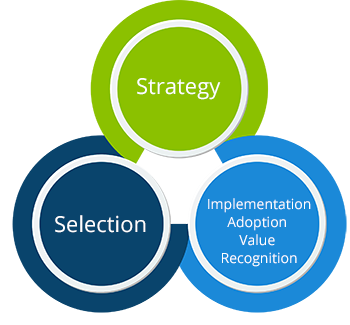Three Steps to Better Sales Technology Investments
- Deciding whether to invest in a new technology and then selecting a vendor can be a daunting task for sales organizations
- Use a consistent evaluation and selection process that incorporates a decision gate at every phase with technology investments
- Our three-phase approach to evaluate, select and implement new sales technology helps to achieve sustained benefits
Technology is one of the top three expenses for sales organizations, right behind personnel costs (e.g. salary and compensation) and hiring, onboarding and training sales reps. Yet, when it comes to making sales technology decisions, even the most sophisticated organizations can sometimes be swayed by hype, market buzz, unrealistic expectations or prior executive experience. Deciding whether to invest in a new technology and then selecting a vendor can be a daunting task. The best approach is to use a consistent evaluation and selection process that incorporates a decision gate at every phase.
-
 Phase 1, strategy, starts before any vendors have been contacted. The strategy phase focuses on defining the project scope, conducting root cause analysis, evaluating costs and benefits, requirements definition and process mapping, and building organizational alignment. Phase 1 also should include consideration of alternatives such as offloading or eliminating the task, or redesigning the underlying process to gain efficiencies and reduce the level of effort. This phase concludes with a go/no decision by executive sponsors. Note that this is NOT an authorization to purchase new technology, but an acknowledgement that, based on what is known about anticipated costs and benefits, the problem is worth addressing and additional discovery should be conducted. Phase 2, selection, begins if the outcome from phase 1 is a recommendation to purchase new technology.
Phase 1, strategy, starts before any vendors have been contacted. The strategy phase focuses on defining the project scope, conducting root cause analysis, evaluating costs and benefits, requirements definition and process mapping, and building organizational alignment. Phase 1 also should include consideration of alternatives such as offloading or eliminating the task, or redesigning the underlying process to gain efficiencies and reduce the level of effort. This phase concludes with a go/no decision by executive sponsors. Note that this is NOT an authorization to purchase new technology, but an acknowledgement that, based on what is known about anticipated costs and benefits, the problem is worth addressing and additional discovery should be conducted. Phase 2, selection, begins if the outcome from phase 1 is a recommendation to purchase new technology. - Phase 2 involves identifying, evaluating and selecting a vendor, culminating in a purchase decision and contract execution. During this phase, project participants gather input from a variety of sources (e.g. analyst reports, white papers, journal articles, peer companies, stakeholders and other internal sources). They use that data to document requirements and construct a weighted decision model. The phase continues with a request for information and/or a request for proposal, vendor demonstrations, reference checks and final selection. Before final contract execution, there should be one more review and approval from the executive sponsors in order to revalidate cost, benefit and priority assumptions.
- Once a vendor has been selected, the project moves into phase 3, which focuses on implementation, adoption and value recognition. A detailed project and change management plan is required to guide implementation efforts. Project leaders and sponsors must recognize that achieving the desired value for both end users and the business continues beyond completion of the initial rollout, as new processes and technologies take time and effort to become part of the standard operating procedure.
Organizations that use this three-phase approach to evaluate, select and implement sales technology are much more likely to achieve sustained, measurable benefits from their technology investments.
